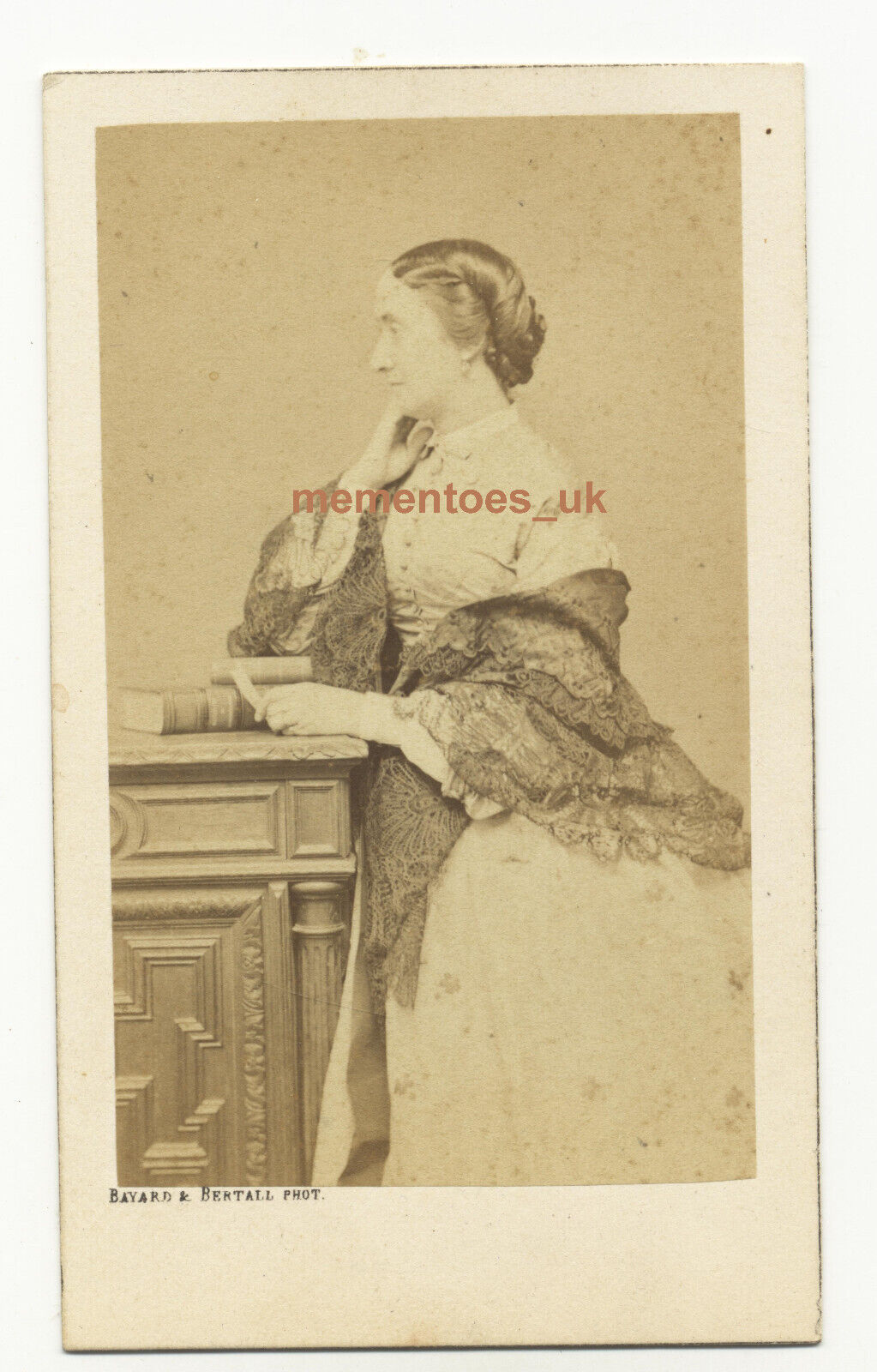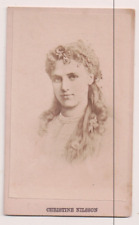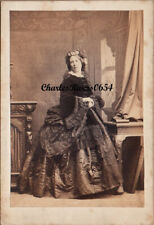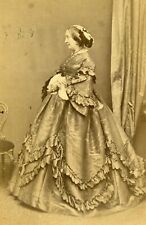|

On eBay Now...
CDV Countess Gobineau Hippolyte Bayard Bertall 1862 Clemence Gabrielle Monnerot For Sale

When you click on links to various merchants on this site and make a purchase, this can result in this site earning a commission. Affiliate programs and affiliations include, but are not limited to, the eBay Partner Network.

CDV Countess Gobineau Hippolyte Bayard Bertall 1862 Clemence Gabrielle Monnerot:
$61.94
Very Rare (never seen an image / photograph of her) Original,vintage, c1862 carte de visite albumen photograph of Countess Gobineau Hippolyte Bayard Bertall 1862 Clemence Gabrielle Monnerot 1816-1911 please see bio below.(she married GOBINEAU, Joseph Arthur de) Famous Photographer Hippolyte Bayard and Charles Bertall studio Paris France Sizeof the cdv is 10cm x 6.5cm approx. Conditionis good (please see scans)
Pleasenote, the ‘mementoes’ logo is not on the actual item.
Postage UK FREE Europe £9.00 (International SignedFor) USA/Worldwide £12.00 (International Signed For) Allitems are professionally packaged in board backed envelopes or paddedenvelopes, both with extra backing card etc. inside to ensure safe arrival ofyour items.
We docombine postage (free postage for each additional eligible item), on ‘Buy itNow’ items please add the items required to your shopping basket and thediscount should automatically be applied, if not please contact us forassistance.
Somenon UK buyers may have to access the listings by logging into the UK site(rather than their own country’s site) to be able to see the ‘ basket’and therefore take advantage of postage combining by using the ‘Add to Basket’facility. Anyproblems please contact us for assistance.
ALL NON UK CUSTOMERS PLEASE NOTE:- ANYIMPORT TAXES/DUTIES ETC DUE MUST BE PAID BY CUSTOMERS UPON DELIVERY TO YOURCOUNTRY, PLEASE CHECK WITH YOUR OWN COUNTRY’S CUSTOMS DEPT. ABOUT RATES ETC.
GOBINEAU, Joseph Arthur de, (b. Ville-d’Avray, near Paris, 14 July 1816; d. Turin, 13 October 1882), French man of letters, artist, polemist, Orientalist, and diplomat, whose influential socio-historical and racial theories were expounded in his writings, and particularly in his Essai sur l’inégalité desraces humaines (hereafter Essai). BIOGRAPHICAL SKETCH Gobineau came from an old and well-established family from Bordeaux. His father Louis (1784-1858), a military officer, was for a time retained in Spain (1823-28), and the son’s education was left to his adventurous mother and her lover, Charles Sottin de la Coindière, who was Arthur’s private tutor. Having failed to enter the military academy of Saint-Cyr (1835), Arthur settled in Paris and lived on an allowance from a wealthy uncle, Thibault-Joseph (1775-1855). He frequented the legitimist circles that supported the elder branch of the Bourbon dynasty and made influential friends. He collaborated with some periodicals and from time to time attended the lectures of the Orientalist Étienne Quatremère (1782-1857) at the Collège de France. In 1846, he married Clémence-Gabrielle Monnerot Destourelles, a Creole from Martinique. They had two daughters. His acquaintance with Alexis de Tocqueville in 1843 was decisive for his diplomatic career. In June 1849, Tocqueville became minister of foreign affairs and appointed him as his chef de cabinet. He then entered the diplomatic service and held the following posts: first secretary, French legation, Bern (1849-53); chargé d’affaires, Hanover (temporary mission, 1851); first secretary, French legation, Frankfurt (1854); secretary, French mission, Tehran (1855-58, chargé d’affaires from October 1856); mission to Newfoundland (1859); minister, Tehran (1862-63); Athens (1864-68); Rio de Janeiro (1869-70); Stockholm (1872-77). Although he took his duties seriously, he was an unruly civil servant and his diplomatic posts enabled him to nurture his restlessness as well as several amorous quests. His liaison with the Contesse Mathilde de la Tour, from 1872, led to his separation from his wife and daughters (1876) and to the selling of his Château de Trye (1878), which had been bought with his uncle’s legacy in 1857, and also accounted for his retirement. During his return visits to France, he was active in local politics and administration. He was elected mayor of Trye in November 1863. During the Franco-Prussian war (1870-71), he succeeded in reducing the excessive war contribution imposed by the Prussians. He resigned from his post as a mayor (November 1870) and witnessed and condemned the Paris Commune insurrection and its aftermath (March-May 1871). From June 1875, he went on travels (Hamburg, Berlin, Paris, and Carlsbad). He accompanied his friend Dom Pedro II, the emperor of Brazil, through Russia, Turkey, and Greece (autumn 1876). After a prolonged tour of Rome, Florence, Vienna, and Berlin, he returned to Paris where the minister of foreign affairs, Louis Descazes, forced him to retire from the service (January 1877). His last years were spent mostly in Italy, with brief sojourns in France and Germany. He settled at Rome in October 1877, aspiring to become a professional sculptor. After a last stay at Madame de la Tour’s Château de Chaméane, Auvergne (summer 1882), he left again for Italy and died in Turin. Gobineau befriended and corresponded with many intellectuals and politicians, and most notably with Alexis de Tocqueville (historian and politician, 1805-59); Anton Prokesch von Osten (Austrian Orientalist and diplomat 1795-1876), met at Frankfurt, 1854; Edward Robert Bulwer-Lytton (1st Earl of Lytton, English diplomat and poet 1831-91, viceroy of India, 1875-80), met at Athens, 1865; Dom Pedro II, emperor of Brazil (1825-91; r. 1841-89), met at Rio, 1869; the counts Florimond de Basterot (1836-1904) and Ugo Sanvitale (1825-86), both met at Rome; Richard Wagner (1813-83), met at Rome, 1876, with whom he stayed at Bayreuth. He also kept a regular correspondence with his family and numerous relations, and with acquaintances both in France and abroad. Although he often expressed his contempt for successive French governments, Gobineau sought official honors eagerly. He was granted the Légion d’Honneur (chevalier, 1851, officier, 1855, commandeur, 1868). He also received major decorations from Germany, Persia, Brazil, and Sweden; but he failed in his attempts to enter the Académie des sciences morales et politiques (1854) and the Académie française (1871). In 1853 he bestowed on himself the title of comte. THE MAN OF LETTERS AND THE ARTIST For a long time, Gobineau enjoyed a higher reputation in Germany than in France, where he has been rehabilitated only recently. From the outset, he was generally perceived as a gifted amateur, his literary production ranging from political articles to verse romances, feuilletons, and a stage play in verse. His early criticism of the French literary establishment made him many enemies (Études critiques 1842-1847). His Essai (1853-55), revealing his interests as a moralist and ethnologist, made little impact beyond the close circle of his friends (Charles de Rémusat, Ernest Renan, and Alfred Maury). He expected but did not receive the approval of Alexis de Tocqueville or of the German Orientalists Georg Heinrich August von Ewald (1803-75) and August Friedrich Pott (1802-87). Initially inspired by the Saint-Simonian ideas of Victor Courtet, the Essai was an eclectic work based on several contemporary German publications, including Ewald’s and Pott’s (see Œuvres I, pp. 1235 ff.). Rather than expounding racial and political problems, this romantic and pessimistic vision of human history delved into the author’s personal myth. His unhappy childhood and youth perhaps accounted for his dark vision of humanity and his permanent quest for his allegedly noble origins. He conceived his three main works as a triptych based on ethnic analysis: the Essai, the Histoire des Perses (1869), and the Histoire d’Ottar Jarl, pirate norvégien (1879), retracing his fanciful genealogy (Œuvres I, pp. 1219, 1279, 1470, note 3). Conceived in his youth, the Essai was the basis of all his future work (Œuvres I, p. 1173). His Persian missions may have been for him a second birth, although his achievements as an Orientalist remain controversial (see iii). From his early youth, he had shown a fondness for such literary figures as Ariosto, Cervantes, Lord Byron, and Sir Walter Scott. He enjoyed reading TheThousand and One Nights (in Antoine Galland’s translation), and he admired medieval chivalrous qualities and endowed his heroes with them. He excelled as a storyteller, and his short stories were filled with his recollections of Greece and Newfoundland (Souvenirs de voyage, 1872) and Persia (Nouvelles asiatiques, 1876). He regarded Les Pléiades (1874) as his best work of fiction in prose (Œuvres III, p. 929). His sudden interest in sculpture (Athens, 1866) occupied much of his time, along with his continuing poetical ambitions, although in both his achievements were somewhat mediocre. He was increasingly haunted in his final years by the notion of European decadence (Œuvres III, Gaulmier’s introduction, p. xlvi f.). Most of Gobineau’s works were published privately. Their limited success made publishers reluctant to reprint them. The second (posthumous) edition of the Essai, with a new preface by Gobineau,was however published through Count de Basterot and his legal executor, Madame de la Tour (1884). But Gobineau’s ideas were first spread in Germany by his German biographer, translator, and editor, Ludwig Schemann (1852-1938), who is regarded as the German father, “père allemand,” of Gobinism (Boissel, 1993, p. 11). He was an early disciple of Wagner, and the composer himself entrusted him with Gobineau’s legacy. He was the founder of the Gobineau-Vereinigung (Gobineau Association, 1894-1919). Studies on Gobineau have continued through the works of scholars like A. B. Duff (Jerusalem), Jean Gaulmier (Strasbourg), Jean Boissel (Montpellier), and their students. Nevertheless, his life and work and his subsequent impact still await full critical analysis. THE ORIENTALIST: GOBINEAU AND PERSIA Gobineau’s early interest in the Orient and his attendance at lectures by prominent Orientalists, such as Étienne Quatremère, Joseph Toussaint Reinaud (1795-1867) and the geographer Jean-Baptiste Benoit Eyriès (1767-1846) have been interpreted as an amateur’s curiosity rather than a scholarly vocation for Oriental studies (Boissel, 1974, pp. 57-64; Œuvres II, Gaulmier’s introduction, p. xii). His involvement in Oriental history became more serious when he became a member of the Société Asiatique (1852) and entertained friendly relations and correspondence with its president Jules Mohl (1800-76). His meeting with Prokesch-Osten and further correspondence with him, notably on numismatics, increased his interest in Orientalism (Gaulmier, ioffer, pp. xiii ff.). But it was his two Persian missions which provided the stimuli and the material for his interest in the east. His keen observations on Persian people, life, customs, religions, art, architecture, etc. were, however, biased by his constant need to verify his racial theories. Moreover, he never acquired sufficient basic training for his ambitious linguistic and historical projects, although apparently he devoted much time in learning Persian with “Mirza Agha,” his informant on dialects (Duff, Lettres persanes, p. 65; Correspondance Prokesch, p. 61). His extant incoherent transcriptions are evidence of his limited knowledge of written Persian poetry and prose. His research on Iranian dialects and his fanciful theories on the origins of the Afghans (Boissel, 1974, pp. 338, 341 ff.) led nowhere. In spite of the research already undertaken by Eugène Burnouf (q.v.), Henry Creswicke Rawlinson, and Jules Oppert, on the decipherment of the cuneiform script (q.v.), Gobineau published his Lecture des textes cunéiformes (1858), conceived as part of a book on the genealogical history of the Iranian nations (see below) and in which he opposed their views. He thought that the cursive script predated the cuneiform, and he regarded the latter as an Iranian invention, and the language of the texts still being used in the 3rd century C.E. (Boissel, 1974, p. 373). The book had a hostile critical reception (Boissel, 1974, pp. 355 ff.). During his second Persian mission, he renewed his contacts with such so-called “scholars” as Rabbi Mollā Lālazār Hamadāni and pursued his cuneiform studies. In his Traité des écritures cunéiformes (1864), based essentially on “rabbinical, Arabic and semiticized Parsi traditions” he further interpreted cuneiform through Gnostic and talismanic notions, resulting in even harsher criticism of his theories (Œuvres II, Gaulmier’s introduction, pp. xlii ff.). From 1856 he started to write parts of his Histoire généalogique des nations iraniennes, published as Histoire des Perses (1869), a work devoid of any scholarly value. Discarding historical chronology and existing European scholarship on the topic, he relied mainly on legendary and epic literature such as the Kuš-nāma (Gaulmier, ioffer. pp. xxiv ff.), whose manuscript he had just acquired. This long post-Ferdowsian epic was also used in his poem “Ferydoun,” which was focused mainly on the antagonism between the Assyrians as Semites and the Iranians as Aryans (Molé, pp. 117 ff.; on Gobineau’s historical method, see Minorsky, pp. 118 f.) His experiences in Persia, however, enabled him to write his three best Oriental works. Trois ans en Asie (1859) is a lively account of his first voyage and sojourn in Persia, which is complemented by his abundant correspondence. Although influenced by his idiosyncratic racial theories and esoteric views, Lesreligions et philosophies dans l’Asie centrale (1865) is based on personal contacts and observations, notably on Babism (q.v.) and its recent evolution (chapters 6-12), and about the taʿzia-ḵᵛāni (chapters 13-16). Apart from Chardin (q.v.) and some English authors, Gobineau is dismissive of previous accounts of Persia by westerners and does not usually quote them. He also expresses a dislike for Joseph Philippe Ferrier (q.v.), who was Rawlinson’s friend (Boissel, 1974, pp. 298ff.). On taʿzia-ḵᵛāni, he does not mention any previous accounts (Calmard, Mécénat, i., pp. 82 ff., 96 ff., 106 ff.; ii., pp. 135 ff.). In his Nouvelles asiatiques (1876), he does, however, acknowledge James Morier’s merits. His “Gambèr-Aly” is a replica of Hajji Baba (q.v.). Most of his heroes and landscapes can be identified from his personal notes and correspondence. This is particularly evident with La danseuse de Shamakha, L’illustre magicien (a dervish from Lahore), and Les amants de Kandahar. His diplomatic experience appears in Gambèr-Aly (in which Jules Richard, later Ričār Khan, appears as M. Brichard) and in La guerre des Turcomans (Henri de Coulibšuf de Blocqueville, a French officer in the shah’s army, appears as “Ghoulam-Hussein”; the story depicts the lack of organization in the Persian army: see Nouvelles asiatiques, 1965, Gaulmier’s preface, pp. li-lxvii). Gobineau’s abilities as a translator from Arabic or Persian were limited. For his French translations of the “Evangile des bâbis,” the “Ketab-e hukkam” (Ketāb al-ḥakkām), and the taʿzia “Les noces de Kassem,” he probably received help from competent Orientalists working in the mission, possibly from Barbier de Meynard (q.v.), or more likely from Amédée Querry (1825-1900), working as a dragoman together with Jean-Baptiste Nicolas (1814-75; see Œuvres II, pp. 1172 ff.). He says that a “Jewish molla” (i.e. Lālazār Hamadāni) helped him to translate into Persian René Descartes’ Discours de la méthode (Boissel, 1993, p. 164). His collection of Oriental manuscripts was saleed at the Hôtel Drouot, Paris, on 6 May 1884. Most of them went to the Oriental collections of the Bibliothèque nationale in Paris and the British Museum (now the British Library) in London. From 1878, he began translating the Kuš-nāma (no. 192/4 in Drouot’s catalogue, now at the British Library, Or. 2780; ed. Jalāl Matini, Tehran, 1377 Š./1998). The unfinished autograph of the translation is kept at Strasbourg (fonds Gobineau, no. 3512; Molé, p. 124). Gobineau worked dutifully at his Persian missions, as first secretary (July 1855-October 1856) and as chargé d’affaires (to January 1858), when he was in charge of British interests following the withdrawal of the British ambassador Charles Augustus Murray as a result of the Anglo-Persian war (1856-57; q.v.). He also had difficulties with the adventurous Richard (March-April 1857; Hytier, Dépêches, pp. 83 ff.). In his second mission, as minister (January 1862-October 1863), he carefully noted the changes and improvements in Persia, particularly in Tehran. He settled the costly ransom for de Blocqueville, who had been taken captive by the Turcomans (ioffer, p. 163). He had problems with some members of Lt. Colonel V. Brongniart’s military mission (1858-67), particularly in settling the case of a certain Captain Rous in a dispute with the Persian government over the delivery of arms (ioffer, pp. 165 ff., 186 ff., 203 f; Boissel, 1993, p. 162). He generally disliked eastern Christians, and particularly the Armenian Catholics in Isfahan (Hytier, Dépêches, pp. 227 ff., 256 ff.). He took in charge the Italian mission (October 1862). While frequenting minor “scholars,” he maintained close contacts with such eminent and learned men as Reżāqoli Khan Hedāyat and Lesān-al-Molk Sepehr, and kept up a constant flow of reports on the political situation within Persia as well as on the external relations with her neighbors. From his childhood, Gobineau had been interested in Oriental studies, including Buddhism and Hinduism, and kept abreast of scholarly publications on these topics, mostly in French and German. While attempting to base his writings on what he considered the best primary research available, he was conscious of his shortcomings (Œuvres II, p. 1081). Although he had many critics, including some Orientalists who criticized the Essai and other related works, his friends (Mohl, Renan, Barbier de Meynard, and others) maintained a favorable view of his Oriental studies. His opinions were also cited by Edward Granville Browne (q.v.), in both his Yearamongst the Persians (London, 1893, index) and in the fourth volume of his Literary History of Persia (London, 1924, index). Vladimir Minorsky also enjoyed Gobineau’s writings, and though he criticized some of his views, he thought he had a good knowledge of spoken Persian (Minorsky, p. 118; Boissel, 1974, p. 324). Along with his pessimistic vision of human history and decadence, Gobineau systematized racial ideas widespread among his predecessors and contemporaries. Soon to become fashionable in German intellectual circles, his theories gave birth to Gobinism, a racist extrapolation of his views about the superiority of the white race and above all the Aryans. Even Babism, whose tenets were first introduced to the general public in Europe through Gobineau, was also at the outset regarded as a kind of Gobinism. He may be considered as a harbinger of genetic racism (Poliakov, p. 244), but it must also be pointed out that his followers misleadingly promoted him as the father of modern political racism, although he was not a Pan-Germanist, an Anti-Semite, or a nationalist. He extolled regionalism and the respect for cultural differences. Political racist theories continued however to be elaborated in his name by such authors as Georges Vacher de Lapouge (1854-1936). Wagner’s son-in-law, Houston Stewart Chamberlain (1855-1927), who had a direct influence on Adolf Hitler, disliked Gobineau’s theories and philosophy (Boissel, 1993, pp. 13, 112). The fiftieth anniversary of Gobineau’s death was officially commemorated at the Sorbonne (Paris, 17 February 1933), and a centennial colloquium was held at the École normale supérieure (Paris, November 1982).


Vintage CDV Georgina Ward, Countess of Dudley British noblewoman $29.99

BASSANO LONDON CDV LADY GEORGIANA SPENCER-CHURCHILL (LATER COUNTESS HOWE) #B285 $36.47

Countess de Morny France CDV Photo Duchess Duchesse Royalty Peerage $75.00

Vintage CDV Christina Nilsson, Countess de Casa Miranda Swedish opera singer $24.99

Infanta Isabel Countess of Girgenti Princess of Asturias 1860s Madrid Spain CDV $50.00

1862 CDV COUNTESS OF GOSFORTH BY CAMILLE SILVY VICTORIAN ANTIQUE PHOTO #6761 $49.27

CDV Countess Gobineau Hippolyte Bayard Bertall 1862 Clemence Gabrielle Monnerot $62.71

Countess Stanhope, Vintage Royalty History CDV Photo by F. Joubert, UK $49.99
|